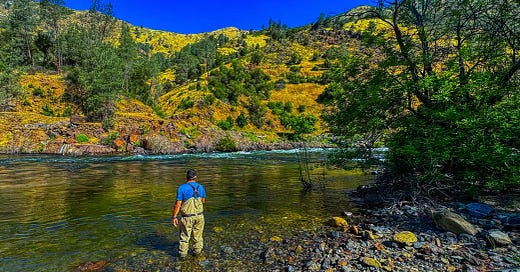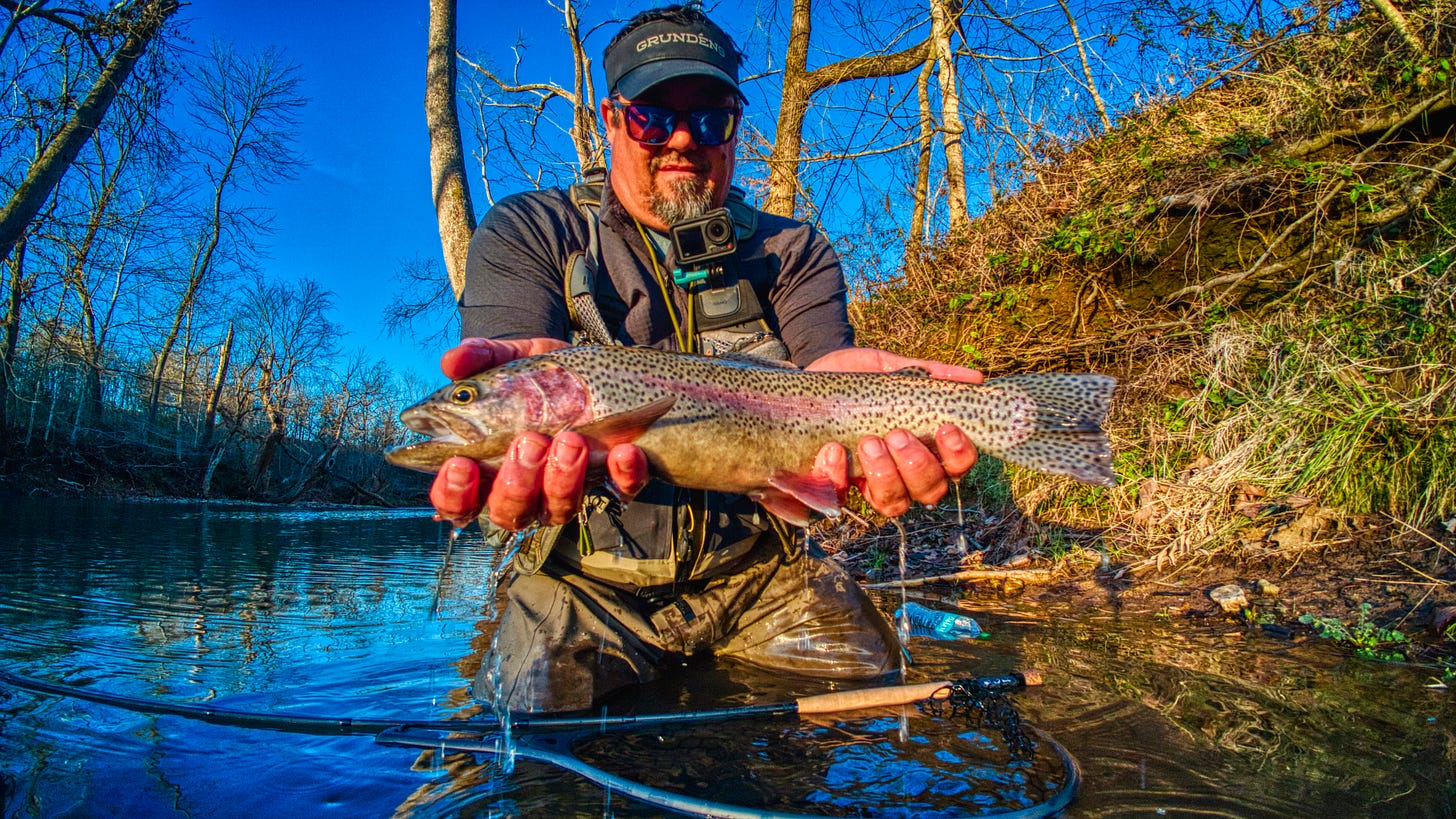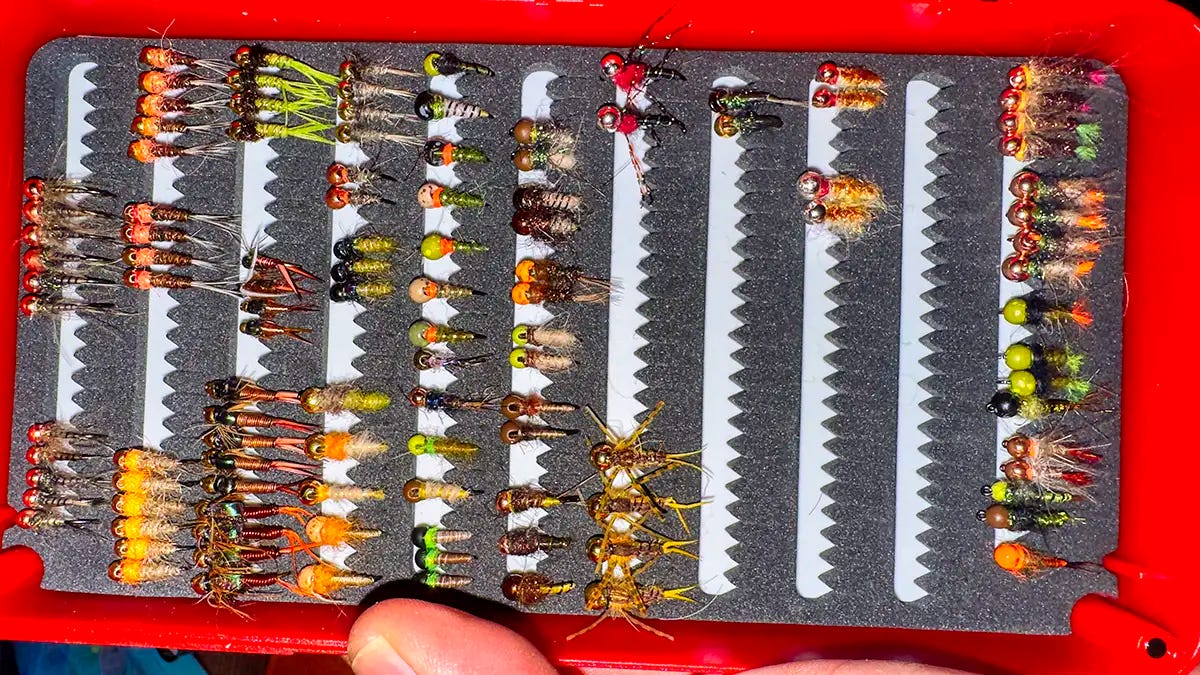Learning to Euro-Nymph in Fly Fishing
Learning any aspect of fishing niches is a simple method of repetition on basic understanding and constant expansion
I grew up fly fishing some of the time, mostly for panfish, smallmouth in streams and some trout fishing in the 1990s and early 2000s. I lived in Arkansas for a time and would spend a lot of my days wading the famed limestone creeks of the Ozarks as well as trekking over to The Little Red River to fish for trout.
I put the fly rods down when I moved to Kentucky in 2005. And, I didn’t pick them back up until a couple years ago. Chasing panfish at first with some light 2 wt and 3 wt rods, I quickly got my casting back and then eventually getting back into fly fishing for trout.
And in the last 20 years, fly fishing has certainly evolved quite a bit with streamers and euro-nymphing being the hot games in town now. So I have been diving in as fast and furious as I can to catch up on my absence. I of course have kept up with all the gear as part of being in the industry, but now I’m back to being a practicing fly fishermen, along with being a big swimbait throwing guy, BFS aficionado, kayak angler, creek wading explorer and long-time river rat who still loves throwing a spinnerbait in muddy water.
Unfortunately, I don’t have much good trout fishing waters nearby. There’s a few creeks on a military base a little over an hour away and a couple more 2 hours away and then most of the decent trout fishing waters are about 4 hours away for me either over in Arkansas and Missouri or further east in Kentucky and Tennessee.
Last year I traveled to California to learn to Euro-Nymph with a guide named Gregory Nespor. He gave me a crash course on it, and I came back and quickly got setup to do it on my own where I have now taken it to other places like Georgia, Arkansas, Missouri, Tennessee and of course Kentucky to fish for trout.
This is one of the newer techniques for me and learning tight-lining weighted flies had a bit of a steep curve at first as most of my experience before that was dries and streamers.
LEARNING EURO-NYMPHING FROM SCRATCH
For those of you like me who have OCD, you can go down the worm hole and watch a lot of videos and read a lot of articles to get a pretty decent understanding of how to euro-nymph or tight-line rig with flies. I shared a bit of my own personal experiences learning to euro-nymph this past year on my own in the video above.
Watching videos and reading articles is not really learning how to fish to me. Learning can only come on the water. And make no mistake, it can be tedious for a bit. But you can really pick up a lot in a day and expand from there.
I will preface all this with a simple statement. I’m not going to try to teach you how to Euro Nymph. I’m no expert at it. And won’t ever claim to be one. I will leave that for the guys who have established themselves as the experts already. But I’m a quick study in all things fishing. And what I hope to share are my own experiences in hopes that I can shorten your learning curve by applying some simple processes to your learning curve.
I will write a separate piece on how to master any fishing skill in series of processes, but for now, I will condense that longer discussion down in this piece to share how I went from novice to proficient at tight lining in a short window on less than great trout waters.
My process is simple. I study on a subject, and then I take that working understanding of methods and gear and go to the water to work on a series of drills to expand my experience and applications with it until I am proficient in my technique and application of it in various situations. You will never know it all, as you will run into new and interesting scenarios all the time that will keep always expanding and fine tuning your approaches to different fishing methodologies. Because these are, after all, wild animals (yes the stocked ones to are wild living organisms).
I’ll explain it through this example of learning to tight-line nymph fish.
KEY TAKEAWAYS OF EURO-NYMPHING
The biggest thing for me has been learning to keep quick and consistent contact with my flies, so I always know what they are doing, no matter what they are doing. I might be letting them dead drift on controlled slack. I might be leading them just a hair to ride them a little higher off the bottom to get a cleaner drift instead of bouncing them on bottom. Or I might even give them a slight undulation to make them seem alive while still up in the strike zone.
That’s all stuff you can experiment with as you run multiple drifts through a seam of water.
After I felt really good about knowing where my flies were in relation to my sighter, then I started learning to read the water. Your sighter is simply colored line above the tippet that you keep out of the water to watch as you drift your flies through the run. I will put some resources at the bottom that will explain all this better than I can. But for me it’s more about the process of learning it and getting proficient with it.
I am pretty good at reading water in conventional fishing, and I’ve always been able to read how fish relate to current. I spent most of my days chasing fish in current growing up and even now, much of my fishing is related to current on major reservoirs. I’ve found with euro-nymphing, reading water can mean a lot of different things, because the trout can be in lots of different types of water. I’ve caught them in inches of water in shallow runs, and deep pools below runs alike and everywhere in between. And tight-lining a piece of water is a super effective way to thoroughly search for trout in almost all waters.
I often am looking for a seam in the current, where the really swift current meets with the slower moving current. Most of the time in a stream or river, the swift current will be on one side or the other, especially where the stream turns and bends around the landscape. The inside water will often be slower than the outside water and the seam where those two meet is often a great place to look for trout with a tight-line rig.
I also like water that runs along cover or makes a turn or dumps into a bit deeper water. I often find trout in all parts of these places. There will be some trout above the run, in the middle of the run just above the deeper waters, and at the bottom where the current changes.
Also learning that the current on the surface is usually much faster than the current below in waters deeper than a couple feet helps. So a lot of times you will notice your nymphs look like they are moving too slow compared to the bubbles going by on the surface. That’s because they are due to the fact they are below that faster water.
I also spent a lot of time reacting to changes in my sighter. After you work your flies multiple times through runs you develop a keen awareness of what your flies do when the bump bottom and when a fish hits them. Controlling that slack and watching for sighter stalls and jumps gets easier as you go.
The nice thing is you can make a short cast, follow it through with your sighter high out of the water, then make another cast and bring it down just a bit and run through again. Eventually you are presenting your flies at the perfect depth and speed and you get bit. From there you will learn to make the best cast and be quick to tight on your sighter so you can detect those early bites and also make a good presentation the first time through to get the fish already setup and ready.
I spent a lot of time playing with the weight of flies, using two flies and one fly, and now I often just fish one fly for a while before experimenting with adding two. I also have come to be very fond of jig streamers. These are mini-streamers really, but they have a tungsten head to get them down and can be fished just like a nymph or like a hybrid streamer. It’s made chasing trout a lot of fun for me, as I feel like on a mono rig, I have a super versatile fishing application when I am using a jig streamer.
It’s paid off for me the past fall and winter, landing some of my bigger holdover trout on the small streams I fish most often.
I can dead drift the jig streamer, I can lead it with some twitches, I can strip it hard and swing it at the bottom of runs. It’s super versatile and works in swift water and slow water alike. Gives you a ton of options with one fly and presentation.
GOOD EURO-NYMPHING RESOURCES
There are lots of good places to learn euro-nymphing gear, techniques and more. I’ll share some of my favorites that helped shorten my learning curve here.
There are other good resources out there, and I’d love to hear of some you like too in the comments. But these will give you a lot to think about when you go try this technique. Again I will not claim to be an expert, but I’ve quickly become very adept at the technique through a good bit of time on the water practicing, testing, experimenting and repeating runs over and over again with good success.
I hope some of these observations help you progress in your own fishing. It’s another one of those crossover techniques in fishing that makes this a natural progression for me in my pursuit of all things fishy. It has a lot of parallels to crappie fishing, bluegill fishing and even bass fishing in current. And even some of the flies can crossover as I’ve caught a ton of nice bluegills, red ear and crappie on flies I’ve tied with tungsten nymph heads and hooks.







